-
CENTRES
Progammes & Centres
Location
 PDF Download
PDF Download 
Kashish Parpiani, “Institutionalising India-U.S. Defence Ties in American Legislative Precedents”, ORF Issue Brief No. 281, February 2019, Observer Research Foundation.
Two years into the Trump presidency, the United States has engaged in a punitive trade war with the world’s second largest economy, undercut allied nations from Western Europe to Northeast Asia over trade deficits, and broken away from policy precedents on US security commitments. For nearly three-quarters of a century since the end of the Second World War, the United States underwrote the global commons: leading the creation of the world’s financial institutions, and building an intricate web of alliances and partnerships aimed at tempering historical rivalries. Indeed, traditional analysts credit Washington for furthering the most prolonged period of prosperity in human history. The US, in the process, consolidated its primacy across economic, military, and soft power metrics. Trump’s unconventional conduct of American foreign policy, however, has informed concerns over the US’ abdication of its long-standing global leadership. The same is apparent amongst US policymakers at the Capitol Hill.
Today, the United States is witnessing a power tussle between the executive and legislature over foreign-policymaking. The framers of the US Constitution indeed meant for the two co-equal branches to check and balance one another on foreign policy matters. For instance, Article II of the US Constitution grants a host of “implied”[1] powers to the president on heading the US armed forces and recognising foreign governments, whilst Congress has jurisdiction over funding of the armed forces, and ratification of multilateral treaties. The current wrangling between the executive and legislature stands unprecedented—ever since Congress in 1973 curbed President Richard Nixon’s powers with the War Powers Resolution.[2]
In stemming the tide against Trump’s erratic conduct of foreign policy, the US Congress has either passed or tabled various bipartisan legislations, resolutions, and “sense of chambers” all aimed at restricting Trump’s unilateral moves at foreign policymaking. These include adding stop-gap provisions on the withdrawal of US troops from South Korea;[3] instituting cessation of funds to halt a possible American withdrawal from NATO (the North Atlantic Treaty Organization);[4] revoking authority to lift sanctions from adversarial nations such as Russia;[5] restraining the president from granting foreign powers access to interrogate former US diplomats;[6] and instituting exemption provisions for partner nations against punitive secondary sanctions.[7]
Therefore, the rising prominence of the US Congress—as the locus of foreign-policymaking shifts away from the Oval Office—is a theme worth examining. Moreover, the recently inducted 116th class of US Congress is the most diverse cohort in terms of race, gender, ethnicity, religion, and veteran status.[8] The chambers are also divided—the Democrats are in control of the House of Representatives, while the Republicans are the majority in the Senate.
In the post-Cold War world, starting with the “natural allies” characterisation of Indo-U.S. ties, there has been an interesting development in the relationship between the two democracies. In recent years, bilateral trade of goods and services has crossed the Obama-era goal of US$ 100 billion[9] and Foreign Direct Investment (FDI) saw a double-digit growth from both ends. From 2016, US FDI in India has seen a 15.1-percent increase, while India’s FDI in the US has witnessed a surge of 11.5 percent.[10]
The most significant development has perhaps been in the realm of defence trade and technology transfers. As the Indian GDP breached the US$ 2.5 trillion mark in 2017,[11] its need for security maximisation also grew. In 2017, India’s defence budget rose by over 5.5 percent from US$ 59.7 billion[12] to US$ 63.9 billion in 2017 to surpass France as the fifth-largest defence spender in the world.[13] Although the lion’s share of that figure goes towards personnel costs, India has emerged as the largest arms importer. In addition to the various geopolitical tensions developing at its Western and Northern borders, India’s need to heavily import arms also stems from excessive red-tape stifling defence R&D and overt reliance on state-owned defence companies.[14] Its planned US$ 250-billion defence modernisation initiative has caused the country’s defence imports to increase by 24 percent, to account for nearly 12 percent of total arms transfers in the world during 2013-17.[15]
Figure 1. Global Defence Spending
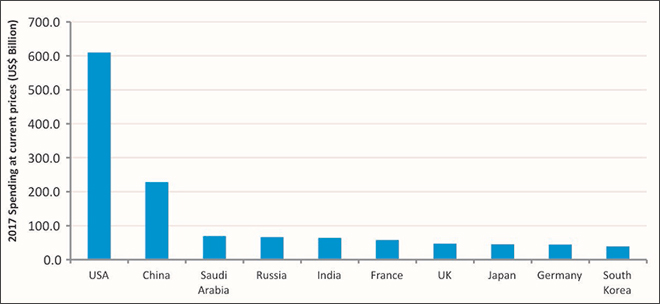
Figure 2. Top Arms Importers
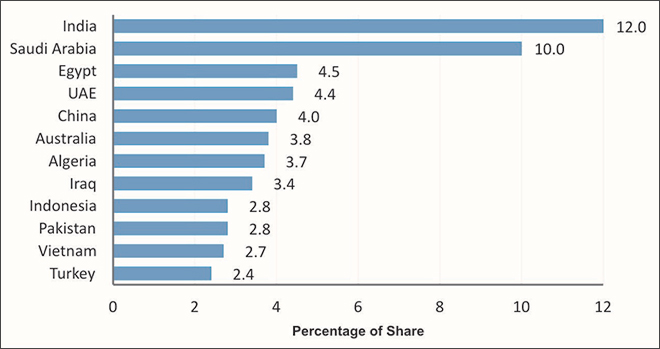
Given this burgeoning Indian market and India’s increasing prominence in Washington’s security calculus in the Indo-Pacific, there have also been substantial gains for the US, which is the largest arms producer and exporter in the world. Of the 100 biggest arms producing companies and military services companies in the world, 42 are American.[16] Of the five largest arms producing companies, four are American — Lockheed Martin (US), Boeing (US), Raytheon (US), BAE Systems (UK), and Northrop Grumman (US).[17] In terms of sales, the US takes the lead, accounting for 57 percent of total global arms sales, with Russia and the UK at a meagre 9.5 percent and 9.0 percent, respectively.[18]
During the period 2013-17, although Russia remained India’s largest supplier of arms by accounting for nearly 62 percent of India’s arms imports,[19] US arms exports to India increased by over 550 percent.[20] Since 2008, Indo-US defence trade has steadily increased from under US$ 1 billion to now over US$ 18 billion,[21] to have the United States assume the spot of India’s second largest arms supplier.[22] Crucial intended or completed procurements include 13 C-130 Hercules aircraft, 10 C-17 Globemaster aircraft, 12 P-8 Poseidon aircraft, 22 AH-64 Apache helicopters, 15 CH-47 Chinook helicopters, and 145 M777 Howitzer guns.[23]
Figure 3. Share of Global Arms Exports
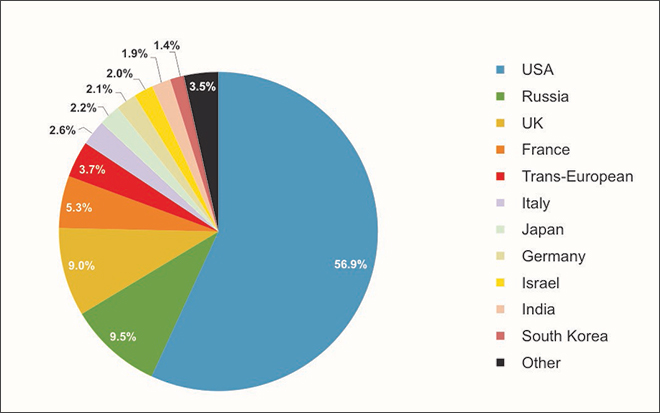
Figure 4. Major arms imports by China, India and Pakistan over the past 20 years
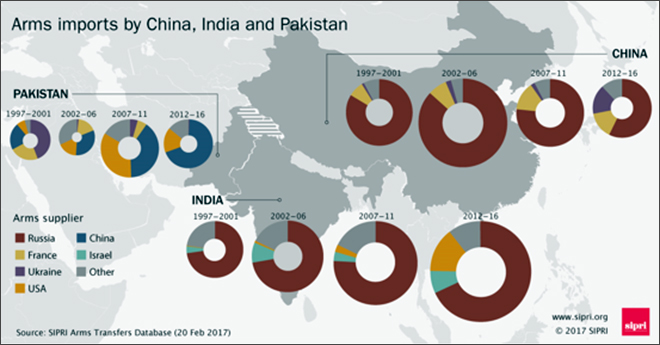
Some of these procurements have already gained prominence in India’s military activities. For instance, India now operates the second largest C-17 Globemaster and P-8 Poseidon fleets in the world.[24] In addition, these procurements have proved crucial for the country’s Humanitarian Assistance and Disaster Relief (HADR) operations. For instance, C-17s have been extensively used to deliver assistance to Nepal after earthquakes, and to evacuate civilians from civil war-torn Yemen.[25]
Furthermore, in 2012, the United States and India launched the Defence Technology and Trade Initiative (DTTI) for co-production and co-development of military equipment –– in order to move away from the traditional “buyer-seller” dynamic.[26] Under the same initiative, the US and India have launched seven joint working groups to explore collaborative projects and programmes: aircraft carriers; jet engines; intelligence, surveillance and reconnaissance; chemical-biological protection; naval systems; and air systems. In addition, it encompasses two Science and Technology government-to-government project agreements –– the Next Generation Protective Ensembles and Mobile Hybrid Power Sources. Under DTTI, apart from the transfer of radar, gas turbine engine, and night-vision technology, cooperation on aircraft carrier design is also on the cards.
Although the US midterm elections in November 2018 led to gains for the Republicans in the US Senate, the Democrats scored a majority in the House of Representatives. The House, which has considerable oversight responsibilities, is expected to take on a larger role in foreign policy decision-making. Moreover, as discussed earlier, many of the initiatives enacted or proposed on the Hill have been bipartisan efforts. Even under the current environment of rigid polarisation, legislators from both sides of the aisle have managed to forge a consensus on certain issues.
A point of consensus relates to the rejection of arms sales to allies and partner nations that tend to prolong US “adventurism”[27] abroad. The rise of Donald Trump is seen as a symptom, rather than cause, of the increasing relevance of so-called “conservative nationalism”. Eclipsing the historical, overt influence of liberal internationalism, conservative nationalism has forged an unlikely point of consensus by pushing the left and the right farther in their respective ends. The contemporary Republican Party is no longer the standard bearer of Reaganesqe “shining city upon a hill”[28] American stewardship of the Western world. Rather, they increasingly detest US involvement in conflicts on behalf of allies and partner nations that shortchange Washington on issues like trade. The Democratic party too, has been captured by its share of populists that would rather prioritise a comprehensive social security net –– in terms of healthcare, education and minimum wage –– over expensive and protracted US activism abroad.
As a result, voices that abhor US activism abroad are gaining prominence. For instance, once derided as a libertarian non-interventionist, Senator Rand Paul (R-KY) does not only have Trump’s ear on issues like State Department nominations, but also stands at the fore in the US Congress on disengaging the country from its entanglements abroad. An increasingly prominent approach to that end is to curb arms sales to allied and partner nations that prolong conflicts abroad –– which by extension renders prospective US retrenchment unlikely. A recent, though unsuccessful, instance being Sen. Paul’s resolution to disapprove the US$ 300 million sale of rocket launchers to Bahrain as a “proxy vote” against US involvement in Yemen.[29] The effort, however, stood defeated to avoid backlash against the 7,800 American personnel stationed in Bahrain as part of US Naval Forces Central Command and the US Fifth Fleet.
Such efforts also stand in tandem with the legislature’s attempts at reversing some of Trump’s lax arms export policies that have reduced transparency and scrutiny. Under the Trump administration, arms sales have been a matter of priority. Last year, Trump approved the US State Department’s “Buy American” plan to boost the country’s arms exports.[30] Termed as the Conventional Arms Transfer policy, it encompasses changes to its International Traffic in Arms Regulations to support defence firms to “directly sell some types of weapons and unmanned drones to allies without the firms having to go through the U.S. government.”[31] Such encouragement of Direct Commercial Sales (DCS) has raised questions about the possible erosion of transparency of the deals vis-à-vis regular Foreign Military Sales (FMS), which are government-to-government sales open to public scrutiny.[32]
Figure 5. Conflicting Partisan Priorities for U.S. Foreign Policy
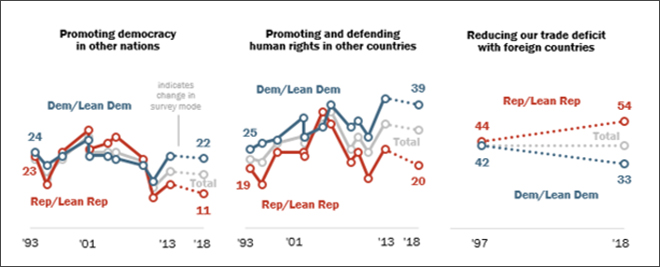
In addition, Trump has also employed a degree of expediency to the matter. In essentially handing Saudi Crown Prince Mohammed Bin Salman a pass over the killing of Saudi dissident and Washington Post columnist, Jamal Ahmad Khashoggi, President Trump cited Riyadh’s intended purchase of US arms totaling a staggering US$ 110 billion.[33] Moreover, in addressing his interest in acquiring fair and reciprocal trade balances, Trump has pushed allied countries like Japan to purchase more US stealth fighter jets to offset trade deficits.[34] As a result of these factors, the Trump era has seen a rise in US arms sales by 33 percent to reach a peak of US$ 55.66 billion in 2018 from about US$ 42 billion in 2017.[35]
Certainly, US Congressmen, too, have a stake in greater volumes of arms sales for two reasons: One, US defence manufacturers employ nearly 2.5 million people across Congressional constituencies;[36] and two, defence contractors most often outshine other industries in corporate Political Action Committee (PAC) donations to Congressional candidates.[37] However, recently, the increased public and media attention to instances like America’s involvement in the Saudi-led bombing campaign in Yemen have led to serious deliberations over US arms export policies.[38] Similarly, deliberations have been underway to curb arms sales to Turkey –– which may employ those very weapons to target the Kurds following a prospective US withdrawal from Syria.[39] Thus, the previous 115th Congress oversaw the tabling of several measures and discussions to curb arms exports to Saudi Arabia,[40] Bahrain,[41] and Turkey,[42] but to little avail. However, now with the Democrats retaking control of the House, some efforts may seriously alter how much leeway the executive exercises over arms sales.
One such effort is the H.R. 7080 Arms Sale Oversight Act,[43] which was introduced late under the 115th Congress by Rep. Ted Lieu (D-CA) and Rep. Jim McGovern (D-MA). This act aims to extend to members of the House the ability to “bring up for debate the merits of problematic arms sales.”[44] Currently, under the Arms Export Control Act, only members of the Senate have the ability to evaluate and question arms sales. Another effort may be the increased employment of Section 201 of Public Law 113-276 passed by the 113th Congress in 2014. The section rests authority with the Chairman and the Ranking Members of the House Foreign Affairs Committee (HFAC) and the Senate Foreign Relations Committee (SFRC) to seek notification of shipment of arms at least 30 days prior to shipping.[45]
The inclination to increase oversight into — if not totally curb, arms sales to tighten processes is only likely to be accentuated under the 116th Congress.
In the impending scenario of greater Congressional oversight and scrutiny into US arms exports, India is unlikely to be in the cross-hairs of Capitol Hill for three reasons: One, support for India on the Hill is largely bipartisan. In the US House of Representatives, the India caucus is the largest country-specific caucus. In the Senate, the India caucus is the only country-specific caucus. Further, the rise of Indian-American legislators — who also have a strong inclination on greater American engagement with India, to prominent positions is certain to influence consolidation of that bipartisan consensus on India. Some notable examples are Rep. Ro Khanna (D-CA) joining the House Armed Services subcommittees on Intelligence and Emerging Threats, and Strategic Forces, as well as the Oversight subcommittees of Government Operations and Economic Policy;[46] and Rep. Pramila Jayapal (D-WA) as the co-chair of the Congressional Progressive Caucus.[47]
Two, India continues to be the US’ coveted arms market. According to a report by the US Department of Defense, India is “modernizing its military and the United States would like to compete for those sales”.[48] Quoting Army Lt. Gen. Charles Hooper (Director, Defence Security Cooperation Agency), the report continues, “We’re very confident that, when given all of the information that they need, they’ll (India will) choose American systems and American services.”[49] In addition to this envisioned rising tempo of Indo-US defence trade in the context of New Delhi’s planned US$ 250-billion defence modernisation initiative, India is a robust civil aviation market as well. The world’s largest aerospace company, Boeing, recently deemed India to “become the third-largest commercial aviation market by the early 2020s”.[50] According to estimates, India is set to order “a record of up to 2,300 new planes worth $320 billion from global planemakers over the next 20 years.”[51]
Three, India, due to its historic insistence on maintaining a certain degree of autonomy has largely avoided the stigma associated with allied and partner nations of the US in these times of rising conservative nationalism. The current political climate, which centres on the United States settling scores over its 70-odd year-period of largesse, has led to derision of allied countries— from Canada to Japan—for their dependence on Washington. India, however, due to its lack of overt dependence on Washington — absent a formal alliance—mostly escapes the ire of conservative nationalists.
The Congressional relevance of India can be seen in instances such as amendments in both chambers to the Arms Export Control Act. Chiefly, the H.R. 4825 – U.S.-India Defense Technology and Partnership Act which designated India as a “U.S. major partner” in matters pertaining to arms sales.[52]
India must concentrate its diplomatic efforts to guard against transactionalism with greater institutionalisation of the Indo-US dynamic in American legislative precedents. Chiefly, India’s efforts must encompass ironing out recent issues such as the downsizing of the India Rapid Reaction Cell at the Pentagon, and seeking the further strengthening of the Indo-US Defence Technology and Trade Initiative (DTTI).
Recently, there were reports that the India Rapid Reaction Cell (IRRC) was downsized and shifted out of the Pentagon to an administrative building six miles away.[53] The only country-specific cell at the Pentagon, the IRRC aims to increase the “operational tempo”[54] of Indo-US co-production and co-development of military equipment. This moving out of the IRRC raised alarms over the future of Indo-US defence ties.
One analysis pointed to current Under Secretary of Defence for Acquisition, Technology and Logistics (AT&L) Ellen Lord.[55] Until recently, Lord served as the CEO of Textron Systems. The American defence company wound up its operations last year as a result of New Delhi levying a hefty fine of US$ 300,000 for failing to meet certain offset commitments to supply precision-guided cluster bombs. The analysis thus inferred that, now as the head of AT&L – which has purview over the IRRC – Lord’s past may have informed the sudden “bureaucratic disinterest” on ramping defence ties with India.[56] Alternatively, one may argue that the IRRC’s shift may be a consequence of Trumpian transactionalism. On trade, although Indo-US trade deficit stands at around US$ 30 billion and India ranks tenth in the list of countries that the US registers a deficit with, Trump has not shied from raising the spectre of levying tariffs. Thus, in line with the president’s inclination to link defence matters to imbalances on the trade front, shunting of the IRRC may be due to the prolonged ongoing negotiations on resolving the trade imbalance between India and the US.
Regardless of which may be the more plausible case, India must seek the grounding of the Indo-US dynamic on defence ties and technology transfers in legislative precedents. The rationale is that seeking legislative underpinnings to the dynamic would make relations less susceptible to the idiosyncrasies of the incumbent executive. It would set the relationship on a long-term and stable footing.
Moreover, on the IRRC, there has been precedent of legislative action. The National Defence Authorization Act (NDAA) for FY 2017, deemed the leadership of the IRRC — and DTTI by extension, to consist of “an individual with experience in defence acquisition and technology to reinforce and ensure the success of the U.S.-India Defence Relationship.”[57] In this vein, the NDAA directed the Department of Defense to reorganise the Office of AT&L into two new Under Secretary positions — one for Research and Engineering and another for Acquisition and Sustainment. The act directed this change to take effect no later than February 2018, and correspondingly put the organisational responsibility for DTTI to be determined as part of the envisioned reorganisation.[58] Subsequently, the department was reorganised, with purview over the IRRC resting with the International Cooperation Office of the Acquisition and Sustainment wing. This helped institute a hands-on approach –– circumventing impediments on bureaucratic levels, to fast-track defence ties.
Going forward, India in its overtures to the 116th Congress must seek greater legislative intervention with regards to the IRRC – so that it does not become susceptible to the foibles of the executive. One possible avenue is through increased committee hearings on the matter. Another is instituting the workings of the IRRC being subject to notifications requested by the chairs and ranking members of the House Foreign Affairs Committee and the Senate Foreign Relations Committee. Further, recently the US Congress passed an amendment to section 1292 of the NDAA for FY 2017 in the H.R.5515 – John S. McCain National Defense Authorization Act for Fiscal Year 2019.[59] The same mandated the executive to submit annual reports on Indo-US defense interoperability. Similarly, amendments may be introduced to mandate annual reports from the executive on Indo-US defence trade and technology transfers under the DTTI mandate.
In addition, in early 2018, it was announced that the Pentagon had agreed to host an Indian military representative at the Defence Innovation Unit Experimental (DIUx). Reportedly, the purpose behind posting an Indian representative at DIUx is to “gain first-hand experience on how the Pentagon and the private sector work together for national security. This unit identifies and invests in companies, including start-ups that fulfil US Department of Defense hardware or software requirements. The Indian representative will be able to identify solutions for the Indian military and explore which ones could work under the “Make in India” rubric.”[60] Given the relevance of this posting to the broader Indo-US initiative of DTTI, the representative must also have purview over the workings of the IRRC so as to alleviate concerns over the absence of an Indian point person at the Pentagon for such purposes.
Lastly, in the inaugural 2+2 meeting between foreign and defence cabinet ministers of India and the United States, the two countries agreed on developing the Industrial Security Annex (ISA). The Annex would support “closer defence industry cooperation and collaboration”[61] via facilitating contacts between like-minded private entities with complementing expertise. In addition, a Memorandum of Intent was signed between the US Defense Innovation Unit (DIU) and the Indian Defence Innovation Organisation — Innovation for Defence Excellence (DIO-iDEX),[62] to explore more projects under DTTI. India must seek the development of these avenues at the earliest so as to initiate more points of contact –– beyond simply the IRRC, across bureaucratic, institutional, and private sector entities on both sides.
The Defence Technology and Trade Initiative (DTTI)—launched in 2012 by India and the US for the co-production and co-development of military equipment—holds the key to both nations’ efforts at prioritising ingenuity and domestic production. With planned or currently underway co-production of arms, the US expands its supply lines, reduces production costs, and gains an upper-hand to tap the burgeoning Indian arms market. For instance, under DTTI initiatives, Boeing has strengthened its supply chain with over 160 domestic partners to support equipment for aircraft like the 777, 787, P-8, F/A-18 Super Hornet, F-15 and H-47 Chinook.[63] Most importantly, domestically, US defence firms engage in “political engineering” defined as “the art of spreading a military project to as many congressional districts as possible, and thus maximizing the number of members of Congress who feel that if they cut off funding, they’d be hurting themselves.”[64] Similarly, on the international level, to capture arms markets and/or reduce production costs, the US spreads production lines of crucial armaments. A case in point is the monopolisation of the huge Israeli fighter jet market – largely a result of Israel being the largest recipient of US defence aid, by outsourcing the production of crucially F-16 wings. Now, reportedly, in contemplating a shift of large sections of its F-16 production lines to India, Lockheed Martin is eyeing a prospective US$ 20-billion market in India for the fighter jets. In addition, the shift would enable Lockheed to free its Fort Worth plant in Texas to cater to the production of the fifth-generation F-35 Joint Strike Fighter that the US Department of Defense plans to transition to.[65]
For India, not only does the DTTI initiate transfer of cutting-edge technology, but also integrates the country into global production supply chains. Tata Advanced Systems Limited (TASL) employs over 300 people at its facility in Hyderabad for co-producing fuselages of the AH-64 Apache helicopters. Indirectly, Boeing India employs over 1,200 people, and another 7,000 attached to its domestic supply chain partners.[66] Furthermore, TASL with Lockheed Martin employs over 80 skilled personnel at India’s first-of-its-kind metal-to-metal bonding facility at Adibatla, Hyderabad.[67] The DTTI therefore also promises gains for the Modi government’s ‘Skill India’[68] initiative to reduce unemployability and harness the potential of its thriving demographic dividend. Expansion of DTTI in the long term may also help temper concerns that Trump’s ‘America First’ focus on US technological ingenuity is essentially incompatible with the Modi government’s push, under its ‘Make in India’[69] vision, for India to lead the world in production.
In a climate of greater Congressional focus on US arms exports, India must iron out impediments like the downsizing of the India Rapid Reaction Cell, and seek further strengthening of the Indo-US Defence Technology and Trade Initiative in legislative precedents.
[1] Jonathan Masters, “US Foreign Policy Powers: Congress and the President,” CFR, 2 March 2017, accessed 20 January 2019.
[2] The War Powers Resolution enacted over an executive veto by President Nixon, mandates Congressional involvement before US forces are deployed abroad. Although the US Constitution rests with the legislature the power to declare war, by the 1970s, the executive branch deployed troops in Korea and Vietnam without such consent. Thus, the War Powers Resolution requires the President to consult with the legislature before committing troops, and in terms of notifying the Hill within 48 hours of forces being deployed. In addition, the same stipulates the executive to end foreign military actions after 60 days unless Congress issues a corresponding declaration of war or Authorization for Use of Military Force (AUMF).
[3] Yonhap News Agency Report, “Trump signs defense bill restricting drawdown of troops in S. Korea”, Yonhap News Agency, 14 August 2018, accessed 24 January 2019.
[4] Sophie Tatum, “Bipartisan bill would prevent Trump from exiting NATO without Senate approval,” CNN, 26 July 2018, accessed January 29 2019.
[5] Marco Rubio, “Rubio, Van Hollen Introduce Legislation to Deter Foreign Interference in American Elections,” Marco Rubio – US Senator for Florida, 16 January 2018, accessed 21 January 2019.
[6] Alana Abramson, “Senate Unanimously Rejects Idea of Allowing Russia to Question U.S. Diplomats”, TIME, 19 July 2018, accessed 21 January 2019.
[7] The Hindu Editorial, “Sanctions relief: on waiver for India under CAATSA”, The Hindu, 26 July 2018, accessed 28 January 2019.
[8] Stef A. Kight, “A look inside the most diverse Congress in history”, Axios, 3 January 2019, accessed 23 January 2019.
[9] Tanya Somanader, “The Highlights of President Obama’s Visit to India”, The Barack Obama White House, 26 January 2016, accessed 29 January 2019.
[10] USTR Report, “U.S.-India Bilateral Trade and Investment”, The Office of the U.S. Trade Representative, 31 July 2018, accessed 19 January 2019.
[11] Yashwant Raj, “India is world’s sixth largest economy at $2.6 trillion, says IMF”, The Hindustan Times, 19 April 2018, accessed 15 February 2019.
[12] SIPRI Database, “SIPRI Military Expenditure Database”, Stockholm International Peace Research Institute, accessed 15 February 2019.
[13] Iian Marlow, “India Joins World’s Top Five Defense Spenders, Surpassing France”, Bloomberg, 2 May 2018, accessed 20 January 2019.
[14] Iian Marlow, “India Joins World’s Top Five Defense Spenders, Surpassing France”, Bloomberg, 2 May 2018, accessed 20 January 2019.
[15] Rajat Pandit, “With 12 percent of global imports, India tops list of arms buyers”, The Times of India, 13 March 2018, accessed 25 January 2019.
[16] Jack Guy, “Russia now second-largest global arms producer, overtaking UK”, CNN, 10 December 2018, accessed 27 January 2019.
[17] SIPRI Report, “THE SIPRI TOP 100 ARMS‑PRODUCING AND MILITARY SERVICES COMPANIES, 2017”, Stockholm International Peace Research Institute, December 2018, accessed 25 January 2019.
[18] Jack Guy, “Russia now second-largest global arms producer, overtaking UK”, CNN, 10 December 2018, accessed 27 January 2019.
[19] Rahul Singh, “India still largest arms importer, spent more than $100 b in last 10 years: SIPRI”, The Hindustan Times, 12 March 2018, accessed 28 January 2019.
[20] The Hindu Report, “India’s arms imports from U.S. up by 550%: report”, The Hindu, 13 March 2018, accessed 10 January 2019.
[21] Sadanand Dhume, “India Is Falling Behind China in an Asian Arms Race”, The Washington Post, 7 February 2019, accessed February 12 2019.
[22] US Embassy Factsheet, “U.S. – India Defense Relations Fact Sheet”, The Embassy of the United States of America in India, 8 December 2016, accessed 18 January 2019.
[23] US Embassy Factsheet, “U.S. – India Defense Relations Fact Sheet”, The Embassy of the United States of America in India, 8 December 2016, accessed 18 January 2019.
[24] Joint Report to Congress, “Enhancing Defense and Security Cooperation with India – Fiscal Year July 2017 – Joint Report to Congress”, The U.S. Department of Defense, July 2017, accessed 20 January 2019.
[25] Joint Report to Congress, “Enhancing Defense and Security Cooperation with India – Fiscal Year July 2017 – Joint Report to Congress”, The U.S. Department of Defense, July 2017, accessed 20 January 2019.
[26] Joint Report to Congress, “Enhancing Defense and Security Cooperation with India – Fiscal Year July 2017 – Joint Report to Congress”, The U.S. Department of Defense, July 2017, accessed 20 January 2019.
[27] In the post 9/11 era, the United States has been engaged in protracted conflicts. Aided by a vaguely-worded Authorisation for Use of Military Force (AUMF) issued in the aftermath of the attacks in 2001, the U.S. has been engaged in also combatting terror outfits or adversaries that had no connection to 9/11. In this vein, many cite the United States’ prolonged conflict against the Islamic State oddly substantiated with the post-9/11 AUMF.
[28] Ronald Reagan, “Farewell Address to the Nation”, UC Santa Barbara American Presidency Project, 11 January 1989, accessed 22 January 2019.
[29] Joe Gould, “US House shelves Yemen vote, but the issue isn’t dead”, Defense News, 15 November 2018, accessed 19 January 2019.
[30] Joe Gould, “Trump advances ‘Buy American’ arms sales plans”, Defense News, 16 July 2018, accessed 26 January 2019.
[31] Joe Gould, “Trump advances ‘Buy American’ arms sales plans”, Defense News, 16 July 2018, accessed 26 January 2019.
[32] Jeff Abramson, “How Congress Can Exert Responsible Oversight on Trump’s Dangerous Approach to Arms Sales”, Arms Control Association, 15 January 2019, accessed 20 January 2019.
[33] Aaron Gregg and Christian Davenport, “Trump again uses arms sales to justify Saudi ties, dragging U.S. defense contractors into an unwelcome debate”, The Washington Post, 20 December 2018, accessed 22 January 2019.
[34] Isabella Steger, “This “pacifist” nation is now the biggest foreign buyer of American F-35 fighter jets”, Quartz,18 December 2018, accessed 17 January 2019.
[35] IANS Report, “Trump administration touts 33% increase in foreign arms sales”, The Economic Times, 11 October 2018, accessed 14 January 2019.
[36] State Department Factsheet, “U.S. Arms Sales and Defense Trade”, The U.S. Department of State, 16 April 2018, accessed 17 January 2019.
[37] Clay Dillow, “Defense contractors outgun other industries in corporate PAC donations”, Fortune Magazine, 15 July 2015, accessed 16 January 2019.
[38] F. Brinley Bruton, “The U.S. wants the Yemen war to end. Will it stop selling arms to Saudi Arabia?”, NBC News, 5 November 2018, accessed 11 January 2019.
[39] Umut Uras, “Why a US defence bill seeks a halt to arms sales to Turkey”, Al Jazeera, 8 May 2018, accessed 10 January 2019.
[40] Niels Lesniewski, “Lawmakers Want to Push Back at Saudi Arabia With or Without Trump”, Roll Call, 20 November 2018, accessed 22 January 2019.
[41] Joe Gould, “US Senate rejects effort to stop Bahrain arms sale”, Defense News, 15 November 2018, 11 January 2019.
[42] Umut Uras, “Why a US defence bill seeks a halt to arms sales to Turkey”, Al Jazeera, 8 May 2018, accessed 10 January 2019.
[43] U.S. Congress, “H.R.7080 – Arms Sale Oversight Act”, The U.S. Congress, 19 October 2018, accessed 12 January 2019.
[44] Ted Lieu, “REPS LIEU AND MCGOVERN INTRODUCE BILL TO IMPROVE HOUSE OVERSIGHT OF ARMS SALES”, Website of Congressman Ted Lieu, 19 October 2018, accessed 12 January 2019.
[45] U.S. Congress, “Public Law 113–276 — 113th Congress”, The U.S. Congress, 18 December 2014, accessed 13 January 2019.
[46] PTI Report, “Indian-American lawmaker joins key Congressional committees”, The Times of India, 25 January 2019, accessed 25 January 2019.
[47] Pramila Jayapal, “Congressional Progressive Caucus Elects Leadership for the 116th Congress”, Website of Congresswoman Pramila Jayapal, 29 November 2018, accessed 22 January 2019.
[48] Jim Garamone, “U.S. Officials Seek to Boost Arms Sales to India”, The U.S. Department of Defense, 6 September 2018, accessed 12 January 2019.
[49] Jim Garamone, “U.S. Officials Seek to Boost Arms Sales to India”, The U.S. Department of Defense, 6 September 2018, accessed 12 January 2019.
[50] Reuters Report, “Indian Carriers Will Need 2,300 Planes Worth Billions In 20 Years: Boeing”, NDTV, 19 December 2018, accessed 11 January 2019.
[51] Reuters Report, “Indian Carriers Will Need 2,300 Planes Worth Billions In 20 Years: Boeing”, NDTV, 19 December 2018, accessed 11 January 2019.
[52] U.S. Congress, “H.R.4825 – U.S.-India Defense Technology and Partnership Act”, The U.S. Congress,22 March 2016, accessed 20 January 2019.
[53] Seema Sirohi, “Pentagon moves India office out, reduces manpower”, The Economic Times, 12 December 2018, accessed 22 January 2019.
[54] PTI Report, “Pentagon creates first ever special cell to speed up defense ties with India”, The Economic Times, 12 July 2018, accessed 20 Janaury 2019.
[55] Seema Sirohi, “Pentagon moves India office out, reduces manpower”, The Economic Times, 12 December 2018, accessed 22 January 2019.
[56] Seema Sirohi, “Pentagon moves India office out, reduces manpower”, The Economic Times, 12 December 2018, accessed 22 January 2019.
[57] Joint Report to Congress, “Enhancing Defense and Security Cooperation with India – Fiscal Year July 2017 – Joint Report to Congress”, The U.S. Department of Defense, July 2017, accessed 20 January 2019.
[58] Joint Report to Congress, “Enhancing Defense and Security Cooperation with India – Fiscal Year July 2017 – Joint Report to Congress”, The U.S. Department of Defense, July 2017, accessed 20 January 2019.
[59] U.S. Congress, “H.R.5515 – John S. McCain National Defense Authorization Act for Fiscal Year 2019”, The U.S. Congress, 13 April 2018, accessed 24 January 2019.
[60] Shishir Gupta, “Soon, India defence attaché at US navy Bahrain command”, The Hindustan Times, 21 March 2018, accessed 12 February 2019.
[61] Ajai Shukla, “2+2 talks: US-India sign COMCASA, agree to do tri-service military exercise”, The Business Standard, 7 September 2018, accessed 11 January 2019.
[62] ET Report, “2+2 Dialogue: India and US sign key military communication pact COMCASA”, The Economic Times, 6 September 2018, accessed 22 Janaury 2019.
[63] Boeing, “Boeing H-47 Chinook Aerostructures Made in India by Dynamatic Technologies”, Boeing India, 27 August 2018, accessed 21 January 2019.
[64] James Fallows, “The Tragedy of the American Military”, The Atlantic, January/February 2015, accessed 12 February 2019.
[65] Sanjeev Miglani, “Lockheed sees potential exports of 200 F-16 jets from proposed Indian plant”, Reuters India, 21 January 2019, accessed 21 January 2019.
[66] Boeing India, “Tata Boeing Aerospace delivers first AH-64 Apache combat helicopter fuselage”, Boeing India, 1 June 2018, accessed 11 January 2019.
[67] Lockheed Martin, “Tata, Lockheed Martin Bring New Cutting-Edge Aerospace Technology To India”, Lockheed Martin, 18 April 2018, accessed 11 January 2019.
[68] Launched by Prime Minister Narendra Modi in 2015, the Skill India initiative aims to train over 40 crore people in India by 2022. The goal being, to enable a large number of India’s youth to take up industry-relevant skill training towards securing better means of livelihood.
[69] Launched by Prime Minister Narendra Modi in 2014, the Make in India initiative was devised to transform India into a global design and manufacturing hub. The same envisions raising the contribution of the manufacturing sector to 25 percent of India’s GDP by 2020.
The views expressed above belong to the author(s). ORF research and analyses now available on Telegram! Click here to access our curated content — blogs, longforms and interviews.

Kashish Parpiani is Senior Manager (Chairman’s Office), Reliance Industries Limited (RIL). He is a former Fellow, ORF, Mumbai. ...
Read More +